Intel Unveils Moorestown and the Atom Z600, The Fastest Smartphone Platform?
by Anand Lal Shimpi on May 4, 2010 11:54 PM EST- Posted in
- Smartphones
- Intel
- Atom
- Mobile
- SoCs
CPU Performance: Moorestown Rocks?
In my iPad review I pointed out the huge gap between the performance of today’s 1GHz smartphone SoCs and an Atom powered netbook.
It’s impossible to estimate the performance of Moorestown without functional hardware, but we can assume that it’s somewhere in between the ARM based SoCs and the netbook in the chart below.
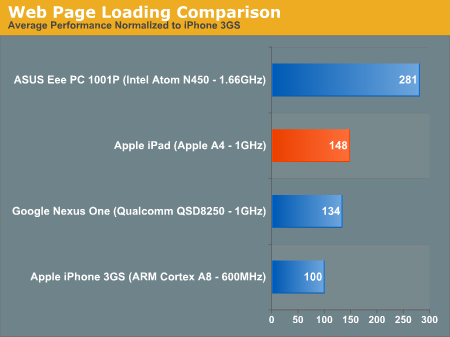
Intel provided some SPECint numbers comparing Moorestown to various smartphone application processors shipping in 2010 (either now or later). Keep in mind that SPECint is just as much of a compiler benchmark as it is a hardware benchmark, so real world performance could very well differ. We won’t know how well Moorestown stacks up until we can evaluate it ourselves. But if Intel’s numbers are even remotely accurate, this is the sort of leap in performance we honestly need in the smartphone space:
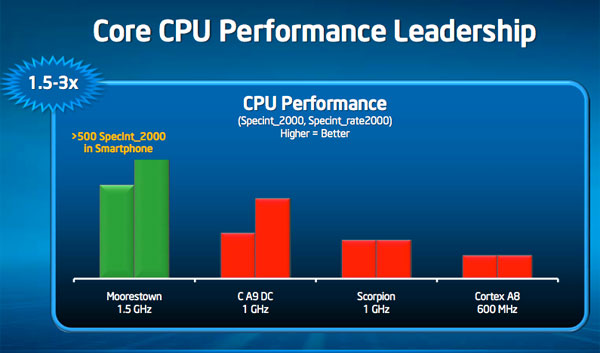
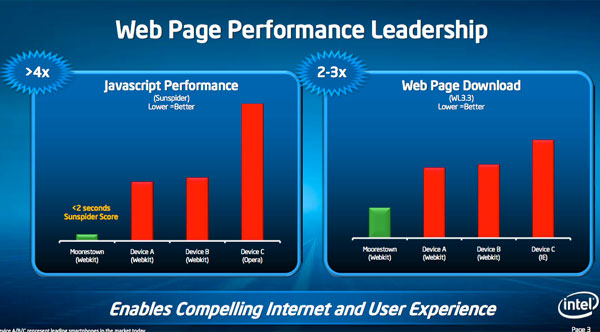
The slowest member of the Atom Z600 series will run at 1.2GHz, the fastest (for smartphones) will run at 1.5GHz. While multithreaded performance on a dual Cortex A9 at 1GHz approaches that of a 1.2GHz Moorestown, nothing can touch the 1.5GHz part. Single threaded performance is just as impressive.
The Sunspider score is super impressive as well. Intel is posting a sub-2s Sunspider score, the best we've seen thus far on a ARM based platform is ~10 seconds on the iPad:
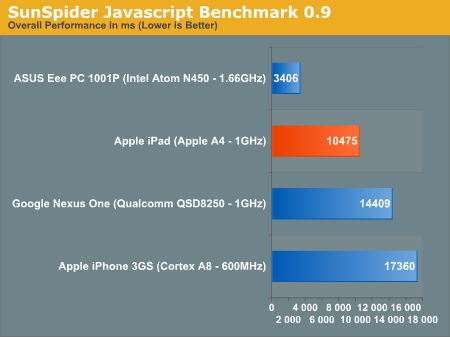
These numbers are from Intel so we have to take them with a grain of salt. And as I already mentioned, we’re looking at pure CPU/compiler performance here - real world application performance is a different story entirely. But it’s a safe bet to assume that Moorestown will at least be faster than any application processor on the market today.
A high clocked dual Cortex A9 could give it a healthy challenge though.
GPU Performance: Moorestown Rules?
Intel provided three numbers to instill confidence in Moorestown’s graphics capabilities. The first was a claim of over 100 fps running Quake 3. I saw this in person so I can confirm that you can actually run a timedemo of Quake 3 at above 100 fps on Moorestown. NVIDIA claims over 40 fps on the Tegra 2 at 720p with AA, but it’s unclear how comparable these numbers are.
The next two numbers are from 3DMark Mobile ES 2.0 using the Taiji and Hoverjet benchmarks:
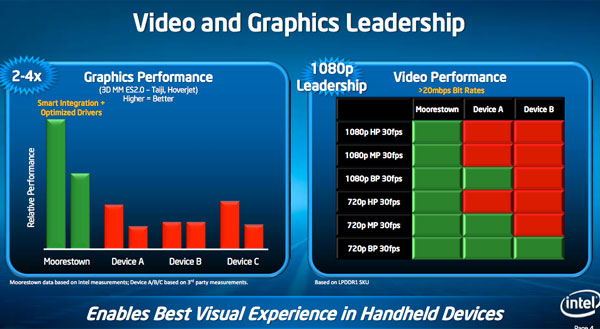
This is comparing the performance of Moorestown to the lower clocked SGX 535 among other GPUs. The performance improvement is more than 2x.
Again, these came from Intel directly so we can’t vouch for their applicability to the real world.










67 Comments
View All Comments
strikeback03 - Thursday, May 6, 2010 - link
Actually, at least on Verizon, there are not many phones that last more than 2-3 days with relatively light use (5-10 min talk, 20-30 txt per day). This is actually something that has gone down in the past few years, as even basic phones get flashier UIs and use more power to run them. And while I support having some phones with weeklong standby time, I am fine with charging my phone or switching batteries every night so long as the phone can last a day in moderate use, which the Snapdragon phones typically can. I like to be able to access more than talk and text on the go.v12v12 - Monday, May 10, 2010 - link
WOW... standing ovation... All of my Droid friends are laughable! Constantly tethered to a power outlet! Always doing something useless and for sure entertainment Vs thinking quietly with their minds... pretty soon "dude I gotta go, my phone is about to die," yeah umm just how many hours have your spent actually TALKING on the dang thing vs playing around with it constantly like some personalized TOY?Battery life should be much more focused upon... The cattle-minded consumers are at it again; now tell me, had to only have 1 car, would you also buy a car that gets the WORST miles per gallon, but has a bunch of silly go-fast features that have you constantly at the fuel pump Vs getting to where you need/should be? Course that's why people usually own 2 cars to separate those needs Vs desires.... Today's "Ferrari" phones have the everyday idiot rambling along, bumping into shit, with their heads constantly fixated on the "screen," like drones. Talking...(?) haha you rarely see people talking with these things, it's just constant "entertainment," even in the most hindering places and social situations. So everyone's got a "Ferrari" phone, but end up trying to use it like a honda; sorry it just doesn't work like that. Faster = more fuel, LESS actual usefulness.
__I'd rather have a phone with a decent amount of enjoyable features, that I can actually take with me on a trip to places that may or may not have power ON-DEMAND lol..
juampavalverde - Wednesday, May 5, 2010 - link
The article and the new product is really interesting, but intel aint ready yet for smartphones, actually this moorestown platform looks much more interesting for pads and handhelds, having more space for such amount of chips, also being x86 with a custom linux. something like an ipad powered by this kind of atom starts to make sense, both from the performance and the battery lifeWorldMage - Thursday, May 6, 2010 - link
The interesting thing about all of the power draw figures given is that they were for workloads wherethe ATOM would be doing almost nothing. Video decode is done by the video decode HW where the
atom might wake up every few seconds to load the next batch of data, similarly for audio playback and
talk time (as you point out cellular modem is the only thing doing work). The thing that gets closest is web browsing, but assuming they are browsing 'static' pages (i.e. no Flash) the atom does a bit of work and probably sits essentially idle for easily 90% of the time.
So it's not surprising they are in the same ballpark as other SOC's for those workloads since they seem to essentially be using the same HW blocks as the competing SOC's. I think it's very telling that all of the power consumption figures from Intel were for essentially non-Atom work loads.
To which you might say "so what?" if those are the work flows that you care about, but that would ignore the fact that the whole point of the atom is to enable "fancy" UI's (and perhaps games) with lots of animation and stuff happening in the background and actually making use of the power of an ATOM.
If you can't actually power the ATOM for an hour of actual use (browsing contacts, checking flights, web pages with Flash ads etc) won't the smart phone be almost worthless?
Th3Loonatic - Thursday, May 6, 2010 - link
On page 3 of the article you misnamed the chips. The one on the left is Lincroft and the one on the right is Langwell.Electrofreak - Friday, May 7, 2010 - link
Anand, Cortex A8 on the 65 nm feature size is reported to use about 0.59 mW per MHz under load, and Cortex A8 on the 45 nm feature size is reported to use 20-30% less than that. For a little bit of added beliveability, Qualcomm's Snapdragon sips in the vicinity of 0.5 mW per MHz on the 65 nm scale, though that may be under optimal circumstances / marketing spin.Ultimately it's roughly half the power consumption Moorestown is reporting. And we notice that nowhere does Intel actually compare their power consumption figures to ARM's.
Additionally, I was under the impression that the A4 had a dual-channel memory controller. I would guess LPDDR2 memory as well, but your guess is as good as mine.
I suspect the S5L8930 in the A4 is a PA Semi (remember Apple bought them) reworked Samsung S5PV210, the dual-channel controller tablet / MID-oriented sister chip to the Samsung Hummingbird S5PC110 (which uses a single-channel controller with LPDDR2 support, if my resources are to be trusted.)
pradeepcvk - Tuesday, November 1, 2011 - link
Anand liked your brief of S0Ix wrt Meego. I wonder how would it work with windows ACPI.could you please have an article for the same.